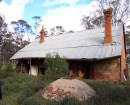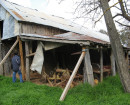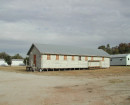OVERHEAD WATER TANK
SPENCER STREET MELBOURNE, MELBOURNE CITY
-
Add to tour
You must log in to do that.
-
Share
-
Shortlist place
You must log in to do that.
- Download report


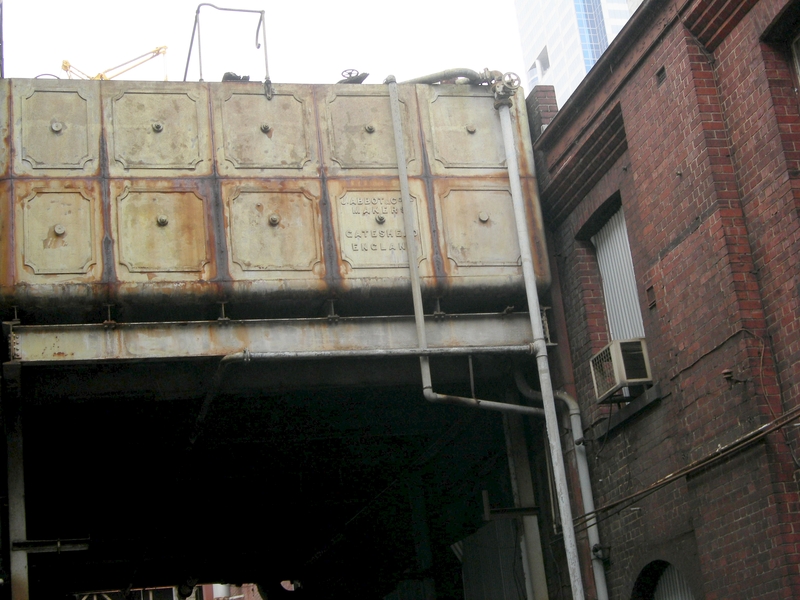
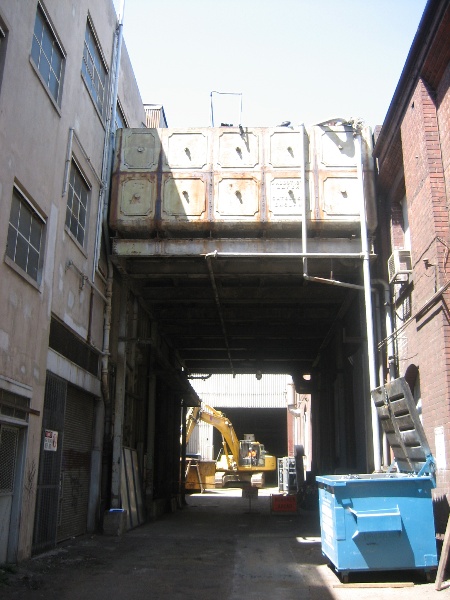
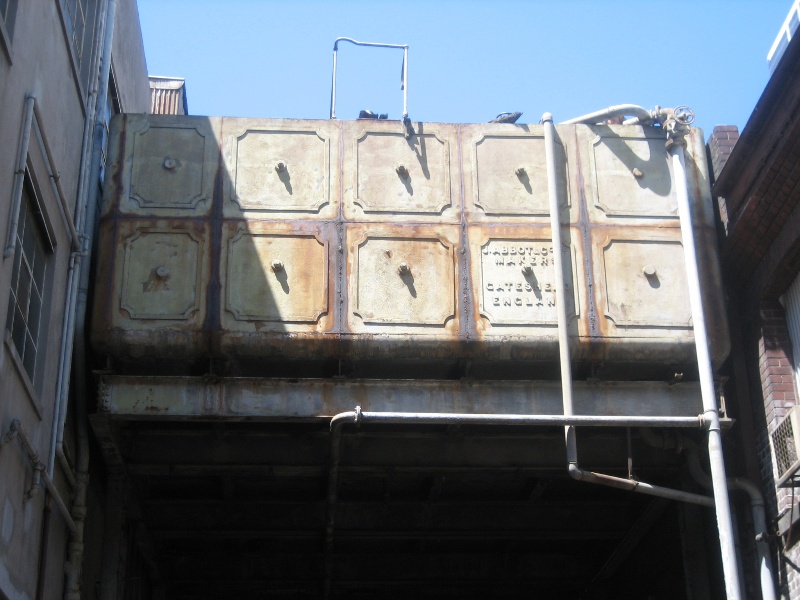
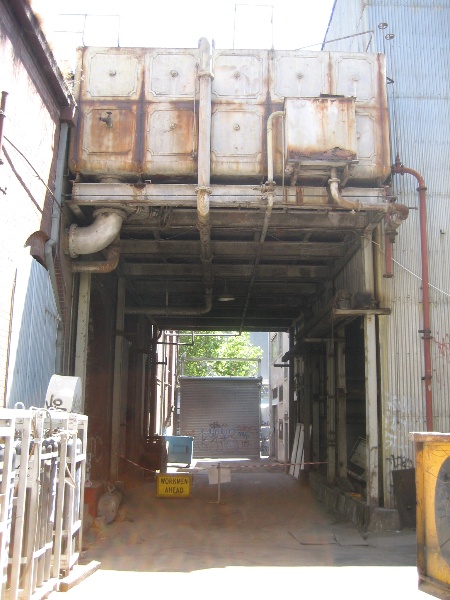

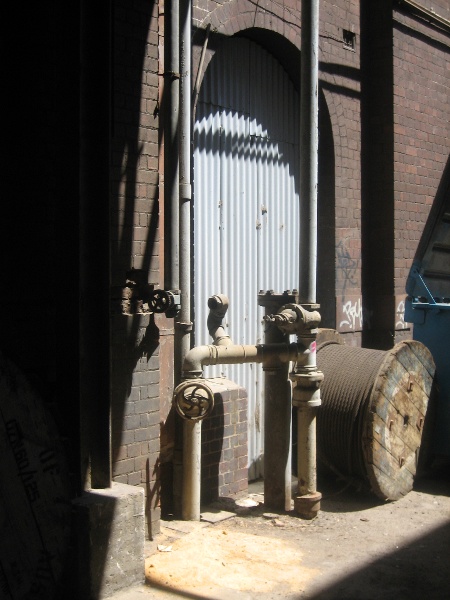

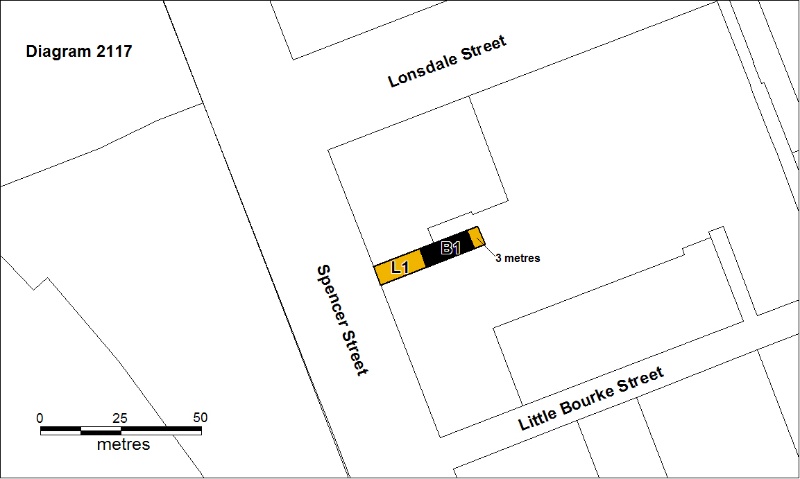
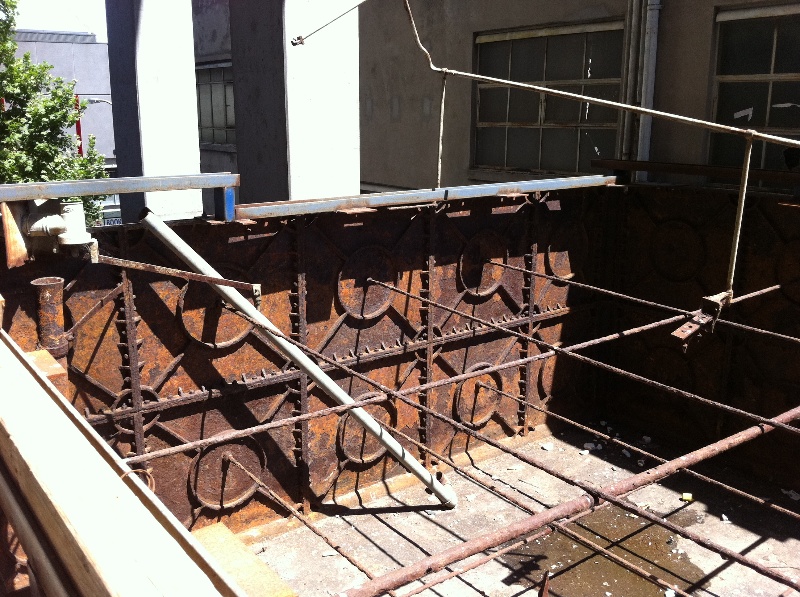
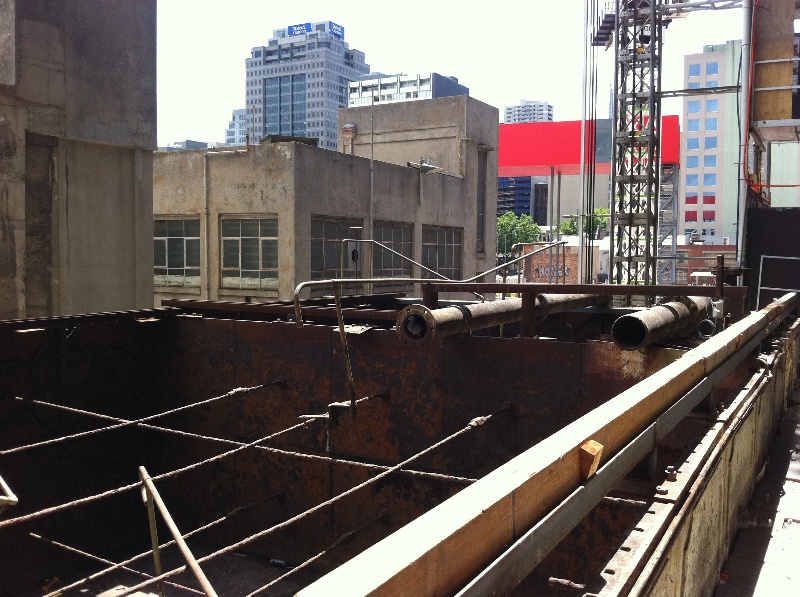
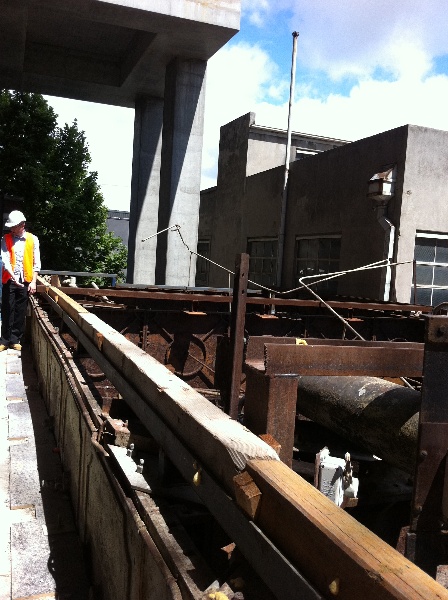
Statement of Significance
The Overhead Water Tank at the Former Spencer Street Power Station is a prefabricated cast iron water tank which was one of two originally built in 1889 by J. Abbot and Co,. Gateshead England for the Hydraulic Power No1 Pumping Station. The pumping station was located adjacent to the Australian Wharf (North Wharf) on the Flinders Street Extension on the north bank of the Yarra River in Melbourne.
The water tank was moved from the No1 Pumping Station and re-erected, albeit with reduced capacity, in its present location in 1927 as part of Melbourne City Council's consolidation of the city's hydraulic power supply at the Spencer Street power station. In its original form it had a capacity of 115, 000 gallons but this was reduced to 58, 000 gallons to suit the requirement of its new use and location. The tank is constructed of prefabricated cast iron panels connected via series tie rods and is supported over a laneway on a steel framed structure. The tank is fourteen panels long (16.916 m) by 5 panels wide (6.1m). The side of the tank are two panels high and it is divided internally into three roughly equal compartments. A number of pipes and valves associated with the function of the tank are extant as are a number of valve covers at ground level which are associated with the supply of water and the distribution of high pressure water.
The hydraulic power system which this tank serviced provided high pressure water for operating lifts and cranes in Melbourne's CBD, South Melbourne and Kensington. Melbourne was the first of only two cities outside England to build a public hydraulic power system. Sydney was the second. Of the two tanks at the No1 Pumping Works, the larger of the tanks received water via gravity from Dight's Falls and in turn supplied a regulated flow to a smaller tank that a provided positive head of water to the pumping engines. It was the larger of the two tanks that was moved to Spencer Street and was used to provide a gravity intake the two Thompson high pressure pumps. Declining use of hydraulic power meant that the hydraulic power service ceased operation on 31 December 1967.
How is it Significant?
The overhead water tank at the former Spencer Street Power Station is of historical and scientific (technical) significance to the State of Victoria.
Why is it Significant?
The overhead water tank at the former Spencer Street Power Station is of historical significance as the only major surviving element of the system that was used to generate and supply hydraulic power to the city of Melbourne from 1889 to 1967. The tank is also significant as the only known surviving element of the original Hydraulic Power Company No.1 Pumping Station.
The overhead water tank at the former Spencer Street Power Station is of scientific (technical) significance as an early and rare surviving example of the use of imported prefabricated cast iron plates. The prefabricated construction of the original tank allowed for its reuse, at a reduced size, to suit the different pumping arrangements at the Spencer Street site. The only other known examples of such tanks are the original Eastern Hill water supply tank now located at the Werribee Sewerage Treatment Plant (H1416) and the prefabricated cast iron tanks located above the Pan House at CSR Yarraville (H1311)
-
-
OVERHEAD WATER TANK - Permit Exemptions
General Exemptions:General exemptions apply to all places and objects included in the Victorian Heritage Register (VHR). General exemptions have been designed to allow everyday activities, maintenance and changes to your property, which don’t harm its cultural heritage significance, to proceed without the need to obtain approvals under the Heritage Act 2017.Places of worship: In some circumstances, you can alter a place of worship to accommodate religious practices without a permit, but you must notify the Executive Director of Heritage Victoria before you start the works or activities at least 20 business days before the works or activities are to commence.Subdivision/consolidation: Permit exemptions exist for some subdivisions and consolidations. If the subdivision or consolidation is in accordance with a planning permit granted under Part 4 of the Planning and Environment Act 1987 and the application for the planning permit was referred to the Executive Director of Heritage Victoria as a determining referral authority, a permit is not required.Specific exemptions may also apply to your registered place or object. If applicable, these are listed below. Specific exemptions are tailored to the conservation and management needs of an individual registered place or object and set out works and activities that are exempt from the requirements of a permit. Specific exemptions prevail if they conflict with general exemptions. Find out more about heritage permit exemptions here.Specific Exemptions:General Conditions: 1.
All exempted alterations are to be planned and carried out in a manner which prevents damage to the fabric of the registered place or object. General Conditions: 2.
Should it become apparent during further inspection or the carrying out of works that original or previously hidden or inaccessible details of the place or object are revealed which relate to the significance of the place or object, then the exemption covering such works shall cease and Heritage Victoria shall be notified as soon as possible. Note: All archaeological places have the potential to contain significant sub-surface artefacts and other remains. In most cases it will be necessary to obtain approval from the Executive Director, Heritage Victoria before the undertaking any works that have a significant sub-surface component. General Conditions: 3.
If there is a conservation policy and plan endorsed by the Executive Director, all works shall be in accordance with it. Note: The existence of a Conservation Management Plan or a Heritage Action Plan endorsed by the Executive Director, Heritage Victoria provides guidance for the management of the heritage values associated with the site. It may not be necessary to obtain a heritage permit for certain works specified in the management plan. General Conditions: 4.
Nothing in this determination prevents the Executive Director from amending or rescinding all or any of the permit exemptions. General Conditions: 5.
Nothing in this determination exempts owners or their agents from the responsibility to seek relevant planning or building permits from the responsible authorities where applicable. Regular Site Maintenance :
The following site maintenance works are permit exempt under section 66 of the Heritage Act 1995: a) regular site maintenance provided the works do not involve the removal or destruction of any significant above-ground features or sub-surface archaeological artefacts or deposits; b) the maintenance of an item to retain its conditions or operation without the removal of or damage to the existing fabric or the introduction of new materials; c) cleaning including the removal of surface deposits, organic growths, or graffiti by the use of low pressure water and natural detergents and mild brushing and scrubbing; d) repairs, conservation and maintenance to plaques, memorials, roads and paths, fences and gates and drainage and irrigation. e) the replacement of existing services such as cabling, plumbing, wiring and fire services that uses existing routes, conduits or voids, and does not involve damage to or the removal of significant fabric. Note: Surface patina which has developed on the fabric may be an important part of the item's significance and if so needs to be preserved during maintenance and cleaning. Note: Any new materials used for repair must not exacerbate the decay of existing fabric due to chemical incompatibility, obscure existing fabric or limit access to existing fabric for future maintenance. Repair must maximise protection and retention of fabric and include the conservation of existing details or elements. Public Safety and Security :
The following public safety and security activities are permit exempt under section 66 of the Heritage Act 1995, a) public safety and security activities provided the works do not involve the removal or destruction of any significant above-ground structures or sub-surface archaeological artefacts or deposits; b) the erection of temporary security fencing, scaffolding, hoardings or surveillance systems to prevent unauthorised access or secure public safety which will not adversely affect significant fabric of the place including archaeological features; c) development including emergency stabilisation necessary to secure safety where a site feature has been irreparably damaged or destabilised and represents a safety risk to its users or the public. Note: Urgent or emergency site works are to be undertaken by an appropriately qualified specialist such as a structural engineer, or other heritage professional. Signage and Site Interpretation :
The following Signage and Site Interpretation activities are permit exempt under section 66 of the Heritage Act 1995, a) signage and site interpretation activities provided the works do not involve the removal or destruction of any significant above-ground structures or sub-surface archaeological artefacts or deposits; b) the erection of non-illuminated signage for the purpose of ensuring public safety or to assist in the interpretation of the heritage significance of the place or object and which will not adversely affect significant fabric including landscape or archaeological features of the place or obstruct significant views of and from heritage values or items; c) signage and site interpretation products must be located and be of a suitable size so as not to obscure or damage significant fabric of the place; d) signage and site interpretation products must be able to be later removed without causing damage to the significant fabric of the place; Note: The development of signage and site interpretation products must be consistent in the use of format, text, logos, themes and other display materials. Note: Where possible, the signage and interpretation material should be consistent with other schemes developed on similar or associated sites. It may be necessary to consult with land managers and other stakeholders concerning existing schemes and strategies for signage and site interpretation. Minor Works :
Note: Any Minor Works that in the opinion of the Executive Director will not adversely affect the heritage significance of the place may be exempt from the permit requirements of the Heritage Act. A person proposing to undertake minor works may submit a proposal to the Executive Director. If the Executive Director is satisfied that the proposed works will not adversely affect the heritage values of the site, the applicant may be exempted from the requirement to obtain a heritage permit. If an applicant is uncertain whether a heritage permit is required, it is recommended that the permits co-ordinator be contacted.OVERHEAD WATER TANK - Permit Exemption Policy
The purpose of the permit exemptions is to allow works that do not impact on the heritage significance of the place to occur without the need for a permit. Works other than those mentioned in the permit exemptions may be possible but will require either the written approval of the Executive Director or permit approval.
The purpose of the Permit Policy is as a guide in assisting when considering or making decisions regarding works to the place. It is recommended that any proposed works be discussed with an officer of Heritage Victoria prior to them being undertaken or a permit is applied for. Discussing any proposed works will assist in answering any questions the owner may have and aid any decisions regarding works to the place.
The significance of the structure lies in being a rare remaining example of its type. Any proposal to alter its size or form should be avoided.
It possible that the tank and its associated fabric could be relocated. However the structure and all of its associated fabric would require full photographic and measured recording to the satisfaction of The Executive Director of Heritage Victoria in situ prior to any removal.
-
-
-
-
-
FORMER ROYAL AUSTRALIAN ARMY MEDICAL CORPS TRAINING DEPOT
 Victorian Heritage Register H0717
Victorian Heritage Register H0717 -
MITRE TAVERN
 Victorian Heritage Register H0464
Victorian Heritage Register H0464 -
MELBOURNE SAVAGE CLUB
 Victorian Heritage Register H0025
Victorian Heritage Register H0025
-
'Lawn House' (Former)
 Hobsons Bay City
Hobsons Bay City -
1 Fairchild Street
 Yarra City
Yarra City -
10 Richardson Street
 Yarra City
Yarra City
-
-






